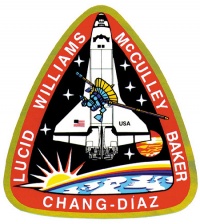STS-34
From The Space Library
 | |
| Organization | NASA-OfficeofSpaceFlight(UnitedStates) |
|---|---|
| Mission type | Earth Science,Human Crew,Solar Physics |
| Launch date | October 18, 1989 |
| Launch vehicle | Space Shuttle |
| Launch site | Cape Canaveral, United States |
| COSPAR ID | 1989-084A |
| Experiments | Here |
| Alternate Names | SSBUV1/STS 34,20297 |
| Additional Information | Here |
| PDMP Information | Here |
| Telecommunications Information | Here |
| Data Collection | Here |
| Payload Mass Up | 22064.0 kg |
STS 34 was the fifth flight of the Atlantis orbiter and the 31st shuttle mission. Its primary mission was the deployment of Galileo. It also carried a secondary payload experiment, the Shuttle Solar Backscatter Ultraviolet Experiment (SSBUV 1), that measured solar irradiance and radiation backscattered from the earth's atmosphere in twelve ultraviolet channels. From these data, total amount and height distribution of ozone could be derived. Essentially, the SSBUV 1 instrument was the same as the SBUV/2 instrument on-board the NOAA polar orbiting satellites except for a few added features including: (1) a transmitter diffuser to transmit sunlight to the SSBUV sensor module; (2) solar and nadir aspect sensors to measure the instruments inclination toward the sun and earth during observations; and (3) an inflight calibration system to perform calibration checks and account for calibration drift. Because of the calibration drift and instrument degradation of the SBUV/2, one main objective of the SSBUV 1 experiment was to operate both experiments in coincidence for calibration purposes. The total duration of this shuttle flight was 4 days, 23 hours, 39 minutes, and 20 seconds for a total of 79 orbits.

